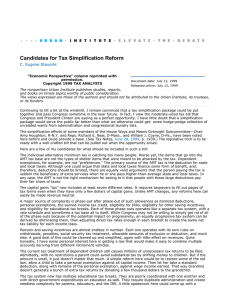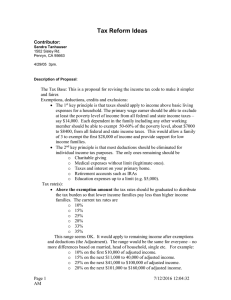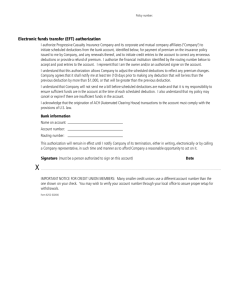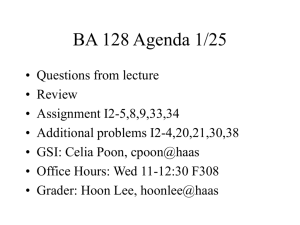The Simple Arithmetic of Flat Taxes C. Eugene Steuerle
advertisement
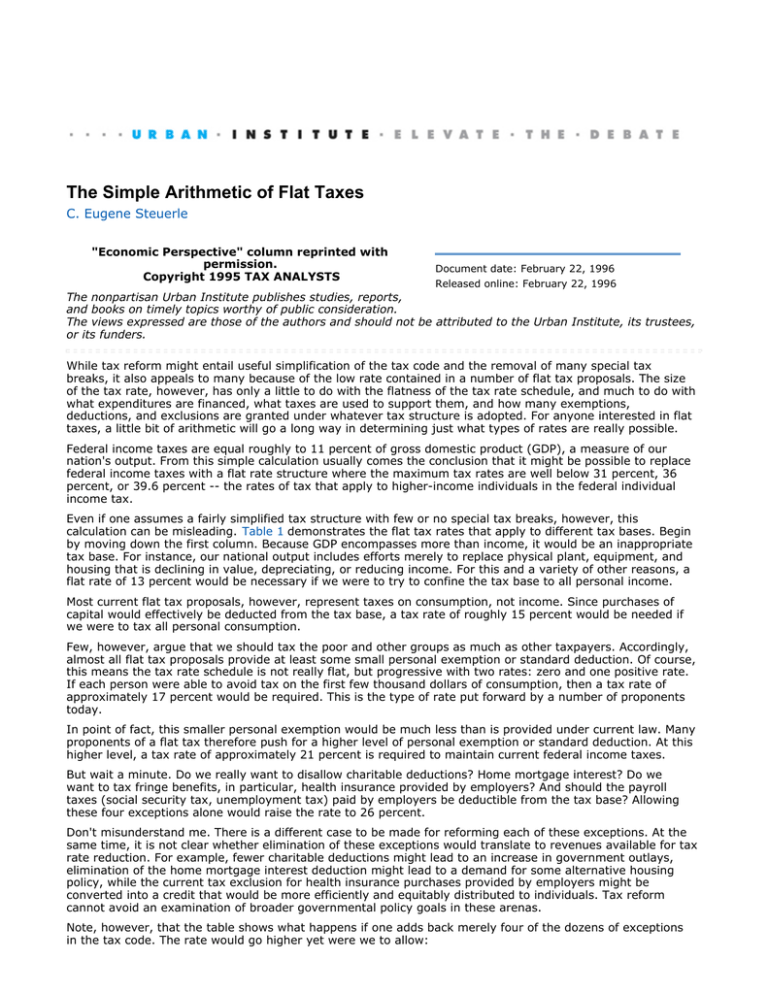
The Simple Arithmetic of Flat Taxes C. Eugene Steuerle "Economic Perspective" column reprinted with permission. Copyright 1995 TAX ANALYSTS Document date: February 22, 1996 Released online: February 22, 1996 The nonpartisan Urban Institute publishes studies, reports, and books on timely topics worthy of public consideration. The views expressed are those of the authors and should not be attributed to the Urban Institute, its trustees, or its funders. While tax reform might entail useful simplification of the tax code and the removal of many special tax breaks, it also appeals to many because of the low rate contained in a number of flat tax proposals. The size of the tax rate, however, has only a little to do with the flatness of the tax rate schedule, and much to do with what expenditures are financed, what taxes are used to support them, and how many exemptions, deductions, and exclusions are granted under whatever tax structure is adopted. For anyone interested in flat taxes, a little bit of arithmetic will go a long way in determining just what types of rates are really possible. Federal income taxes are equal roughly to 11 percent of gross domestic product (GDP), a measure of our nation's output. From this simple calculation usually comes the conclusion that it might be possible to replace federal income taxes with a flat rate structure where the maximum tax rates are well below 31 percent, 36 percent, or 39.6 percent -- the rates of tax that apply to higher-income individuals in the federal individual income tax. Even if one assumes a fairly simplified tax structure with few or no special tax breaks, however, this calculation can be misleading. Table 1 demonstrates the flat tax rates that apply to different tax bases. Begin by moving down the first column. Because GDP encompasses more than income, it would be an inappropriate tax base. For instance, our national output includes efforts merely to replace physical plant, equipment, and housing that is declining in value, depreciating, or reducing income. For this and a variety of other reasons, a flat rate of 13 percent would be necessary if we were to try to confine the tax base to all personal income. Most current flat tax proposals, however, represent taxes on consumption, not income. Since purchases of capital would effectively be deducted from the tax base, a tax rate of roughly 15 percent would be needed if we were to tax all personal consumption. Few, however, argue that we should tax the poor and other groups as much as other taxpayers. Accordingly, almost all flat tax proposals provide at least some small personal exemption or standard deduction. Of course, this means the tax rate schedule is not really flat, but progressive with two rates: zero and one positive rate. If each person were able to avoid tax on the first few thousand dollars of consumption, then a tax rate of approximately 17 percent would be required. This is the type of rate put forward by a number of proponents today. In point of fact, this smaller personal exemption would be much less than is provided under current law. Many proponents of a flat tax therefore push for a higher level of personal exemption or standard deduction. At this higher level, a tax rate of approximately 21 percent is required to maintain current federal income taxes. But wait a minute. Do we really want to disallow charitable deductions? Home mortgage interest? Do we want to tax fringe benefits, in particular, health insurance provided by employers? And should the payroll taxes (social security tax, unemployment tax) paid by employers be deductible from the tax base? Allowing these four exceptions alone would raise the rate to 26 percent. Don't misunderstand me. There is a different case to be made for reforming each of these exceptions. At the same time, it is not clear whether elimination of these exceptions would translate to revenues available for tax rate reduction. For example, fewer charitable deductions might lead to an increase in government outlays, elimination of the home mortgage interest deduction might lead to a demand for some alternative housing policy, while the current tax exclusion for health insurance purchases provided by employers might be converted into a credit that would be more efficiently and equitably distributed to individuals. Tax reform cannot avoid an examination of broader governmental policy goals in these arenas. Note, however, that the table shows what happens if one adds back merely four of the dozens of exceptions in the tax code. The rate would go higher yet were we to allow: state and local tax deductions; tax breaks for state and local bonds; earned income tax credits or other low-income wage subsidies; deductions for catastrophic losses; research and development tax credits; special new breaks to avoid a double tax on those consuming out of income on which tax had already been paid; and allowances for businesses to take depreciation allowances for capital they purchased before the new tax went into effect. Any tax reform effort should examine each of these issues in its own right. Each one that is retained -- or replaced with an alternative subsidy or expenditure -- would add to the tax rate required under a flat rate tax. If the flat tax has merit, however, one must raise the question of why it is often proposed only to replace the most progressive of existing taxes, and not many other taxes that tend to be more regressive than a flat rate tax. Most flat tax proposals do go beyond the federal personal income tax to cover the corporate income and estate taxes as well. But they stop short when it comes to the social security tax, unemployment tax, and a variety of excise taxes. Federal income taxes, it turns out, represent only about one-half of all federal taxes and one-third of all federal, state, and local taxes -- and even this is an understatement, if one adds in the many fees (e.g., for parks) and premiums (e.g., for Medicare) charged by government. Suppose that we were to achieve significant tax reform by limiting exceptions to the tax base to a large personal exemption and the four items listed in the last row of the table, and that we succeeded in reforming the tax system to eliminate dozens of other exceptions. We then decided to collect all federal taxes through this tax structure. Then a 46 percent tax rate would be required. If our notion is that a flat rate structure was the fairest of all possible structures, however, we would also need to take into account state and local taxes. These tend to be more regressive than federal taxes. If we were to fold state and local taxes into a new rate structure, then the tax rate would need roughly to triple from what would be required if only federal income taxes were replaced. One needn't stop here. One could also let the flat rate structure replace all those fees and premiums and tolls that extract a much larger percentage of the income of lower-income taxpayers. These various charges do not show up in government accounts as taxes, but as negative expenditures. One could also raise the rate high enough to cover the deficit or, even more radically, to cover the cost of all future promises, e.g., for social security and Medicare, through a tax rate that would be flat over time. In these cases, the tax rate could easily rise to more than 90 percent. At first, these numbers may appear astounding. Remember, however, that federal, state, and local expenditures currently are 34 percent of GDP and are scheduled to rise to over 40 percent under current law. It's hard to think of any tax base, when multiplied by 17 percent or 20 percent, that will cover the costs of such expenditures. Remember also that most of the increases in taxes over the past few decades derived not from increases in federal income taxes -- where rates have fallen -- but from expansion of taxes with relatively flat or slightly regressive rates, such as the social security tax in the U.S. and the value added tax in most of the rest of the industrial world. The simple arithmetic of tax reform reveals that there is no free ride. Improvements in fairness and simplification are possible, but they require not a wave of the hand, but step by step examination of almost every government program in the tax code or in theexpenditure system. This is very hard work, it doesn't promise that everyone will be a winner when the legislation is finally drafted, and it can't be done without employing some basic arithmetic. Other Publications by the Authors C. Eugene Steuerle Usage and reprints: Most publications may be downloaded free of charge from the web site and may be used and copies made for research, academic, policy or other non-commercial purposes. Proper attribution is required. Posting UI research papers on other websites is permitted subject to prior approval from the Urban Institute—contact publicaffairs@urban.org. If you are unable to access or print the PDF document please contact us or call the Publications Office at (202) 261-5687. Disclaimer: The nonpartisan Urban Institute publishes studies, reports, and books on timely topics worthy of public consideration. The views expressed are those of the authors and should not be attributed to the Urban Institute, its trustees, or its funders. Copyright of the written materials contained within the Urban Institute website is owned or controlled by the Urban Institute. Source: The Urban Institute, © 2012 | http://www.urban.org
